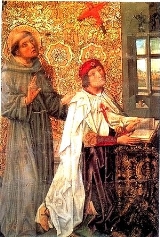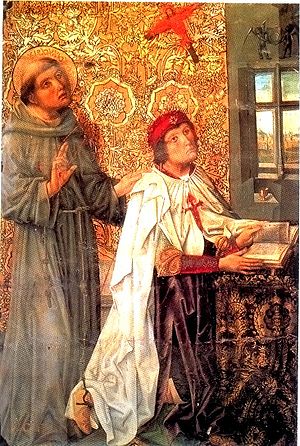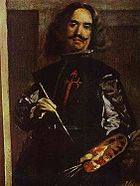
Order of Santiago
Encyclopedia
- This article deals with the Spanish Order of knighthood. For the Portuguese Order, see Order of St. James of the Sword.
The Order of Santiago was founded in the 12th century, and owes its name to the national patron of Galicia and Spain
Spain
Spain , officially the Kingdom of Spain languages]] under the European Charter for Regional or Minority Languages. In each of these, Spain's official name is as follows:;;;;;;), is a country and member state of the European Union located in southwestern Europe on the Iberian Peninsula...
, Santiago (St. James the Greater), under whose banner the Christians of Galicia and Asturias
Asturias
The Principality of Asturias is an autonomous community of the Kingdom of Spain, coextensive with the former Kingdom of Asturias in the Middle Ages...
began in the 9th century to combat and drive back the Muslims of the Iberian Peninsula
Iberian Peninsula
The Iberian Peninsula , sometimes called Iberia, is located in the extreme southwest of Europe and includes the modern-day sovereign states of Spain, Portugal and Andorra, as well as the British Overseas Territory of Gibraltar...
.
History

Santiago de Compostela
Santiago de Compostela is the capital of the autonomous community of Galicia, Spain.The city's Cathedral is the destination today, as it has been throughout history, of the important 9th century medieval pilgrimage route, the Way of St. James...
, in Galicia, the centre of devotion to this Apostle, is neither the cradle nor the principal seat of the order. Two cities contend for the honour of having given it birth, León in the kingdom of that name
Kingdom of León
The Kingdom of León was an independent kingdom situated in the northwest region of the Iberian Peninsula. It was founded in AD 910 when the Christian princes of Asturias along the northern coast of the peninsula shifted their capital from Oviedo to the city of León...
, and Uclés
Uclés
Uclés is a municipality located in the province of Cuenca, Castile-La Mancha, Spain. According to the 2004 census , the municipality has a population of 287 inhabitants....
in Castile
Kingdom of Castile
Kingdom of Castile was one of the medieval kingdoms of the Iberian Peninsula. It emerged as a political autonomous entity in the 9th century. It was called County of Castile and was held in vassalage from the Kingdom of León. Its name comes from the host of castles constructed in the region...
. At that time (1157–1230) the royal dynasty was divided into two rival branches, which rivalry tended to obscure the beginnings of the order. The Knights of Santiago had possessions in each of the kingdoms, but Ferdinand II of León
Ferdinand II of Leon
Ferdinand II was King of León and Galicia from 1157 to his death.-Life:Born in Toledo, Castile, he was the son of King Alfonso VII of León and Castile and of Berenguela, of the House of Barcelona. At his father's death, he received León and Galicia, while his brother Sancho received Castile and...
and Alfonso VIII of Castile
Alfonso VIII of Castile
Alfonso VIII , called the Noble or el de las Navas, was the King of Castile from 1158 to his death and King of Toledo. He is most remembered for his part in the Reconquista and the downfall of the Almohad Caliphate...
, in bestowing them, set the condition that the seat of the order should be in their respective states. Hence arose long disputes which only ended in 1230 when Ferdinand III, the Saint
Ferdinand III of Castile
Saint Ferdinand III, T.O.S.F., was the King of Castile from 1217 and León from 1230. He was the son of Alfonso IX of León and Berenguela of Castile. Through his second marriage he was also Count of Aumale. He finished the work done by his maternal grandfather Alfonso VIII and consolidated the...
, united both crowns. Thenceforth, Uclés, in Cuenca Province, was regarded as the headquarters of the order; there the grand master habitually resided, aspirants passed their year of probation, and the rich archives of the order were preserved until united in 1869 with the "Archivo Histórico Nacional" of Madrid
Madrid
Madrid is the capital and largest city of Spain. The population of the city is roughly 3.3 million and the entire population of the Madrid metropolitan area is calculated to be 6.271 million. It is the third largest city in the European Union, after London and Berlin, and its metropolitan...
. The order received its first rule in 1171 from Cardinal Jacinto (later Pope Celestine III
Pope Celestine III
Pope Celestine III , born Giacinto Bobone, was elected Pope on March 21, 1191, and reigned until his death. He was born into the noble Orsini family in Rome, though he was only a cardinal deacon before becoming Pope...
), then legate in Iberia of Pope Alexander III
Pope Alexander III
Pope Alexander III , born Rolando of Siena, was Pope from 1159 to 1181. He is noted in history for laying the foundation stone for the Notre Dame de Paris.-Church career:...
.

Order of Calatrava
The Order of Calatrava was the first military order founded in Castile, but the second to receive papal approval. The papal bull confirming the Order of Calatrava as a Militia was given by Pope Alexander III on September 26, 1164.-Origins and Foundation:...
and Alcántara
Order of Alcántara
The Order of Alcántara , also called the Knights of St. Julian, was originally a military order of León, founded in 1166 and confirmed by Pope Alexander III in 1177.-Alcántara:...
, which followed the severe rule of the Benedictines of Cîteaux, Santiago adopted the milder rule of the Canons of St. Augustine
Augustinians
The term Augustinians, named after Saint Augustine of Hippo , applies to two separate and unrelated types of Catholic religious orders:...
. In fact at León they offered their services to the Canons Regular of Saint Eligius
Saint Eligius
Saint Eligius is the patron saint of goldsmiths, other metalworkers, and coin collectors. He is also the patron saint of the Royal Electrical and Mechanical Engineers , a corps of the British Army, but he is best known for being the patron saint of horses and those who work with them...
in that town for the protection of pilgrims to the shrine of St. James and the hospices on the roads leading to Compostela. This explains the mixed character of their order, which is hospitaller and military, like that of St. John of Jerusalem
Knights Hospitaller
The Sovereign Military Hospitaller Order of Saint John of Jerusalem of Rhodes and of Malta , also known as the Sovereign Military Order of Malta , Order of Malta or Knights of Malta, is a Roman Catholic lay religious order, traditionally of military, chivalrous, noble nature. It is the world's...
. They were recognized as religious by Pope Alexander III, whose Bull of 5 July 1175, was subsequently confirmed by more than twenty of his successors. These pontifical acts, collected in the Bullarium
Bullarium
Bullarium is a term commonly applied to a collection of papal bulls and other analogous documents, whether the scope of the collection be general in character, or limited to the bulls connected to any particular order, or institution, or locality.-Origins:...
of the order, secured them all the privileges and exemptions of other monastic orders. The order comprised several affiliated classes: canons, charged with the administration of the sacraments; canonesses, occupied with the service of pilgrims; religious knights living in community, and married knights. The right to marry, which other military order
Military order
A military order is a Christian society of knights that was founded for crusading, i.e. propagating or defending the faith , either in the Holy Land or against Islam or pagans in Europe...
s only obtained at the end of the Middle Ages
Middle Ages
The Middle Ages is a periodization of European history from the 5th century to the 15th century. The Middle Ages follows the fall of the Western Roman Empire in 476 and precedes the Early Modern Era. It is the middle period of a three-period division of Western history: Classic, Medieval and Modern...
, was accorded them from the beginning under certain conditions, such as the authorization of the king, the obligation of observing continence
Incontinence (philosophy)
Incontinence is often used by philosophers to translate the Greek term Akrasia . Often used to refer to a lacking in moderation or self-control, especially related to sexual desire...
during Advent
Advent
Advent is a season observed in many Western Christian churches, a time of expectant waiting and preparation for the celebration of the Nativity of Jesus at Christmas. It is the beginning of the Western liturgical year and commences on Advent Sunday, called Levavi...
, Lent
Lent
In the Christian tradition, Lent is the period of the liturgical year from Ash Wednesday to Easter. The traditional purpose of Lent is the preparation of the believer – through prayer, repentance, almsgiving and self-denial – for the annual commemoration during Holy Week of the Death and...
, and on certain festivals of the year, which they spent at their monasteries in retreat.
The mildness of this rule furthered the rapid spread of the order, which eclipsed the older orders of Calatrava and Alcántara, and whose power was reputed abroad even before 1200. The first Bull of confirmation, that of Pope Alexander III, already enumerated a large number of endowments. At its height Santiago alone had more possessions than Calatrava and Alcántara together. In Spain these possessions included 83 commanderies, of which 3 were reserved to the grand commanders, 2 cities, 178 boroughs and villages, 200 parishes, 5 hospitals, 5 convents, and 1 college at Salamanca
Salamanca
Salamanca is a city in western Spain, in the community of Castile and León. Because it is known for its beautiful buildings and urban environment, the Old City was declared a UNESCO World Heritage Site in 1988. It is the most important university city in Spain and is known for its contributions to...
. The number of knights was then 400 and they could muster more than 1000 lances. They had possessions in Portugal
Portugal
Portugal , officially the Portuguese Republic is a country situated in southwestern Europe on the Iberian Peninsula. Portugal is the westernmost country of Europe, and is bordered by the Atlantic Ocean to the West and South and by Spain to the North and East. The Atlantic archipelagos of the...
, France
France
The French Republic , The French Republic , The French Republic , (commonly known as France , is a unitary semi-presidential republic in Western Europe with several overseas territories and islands located on other continents and in the Indian, Pacific, and Atlantic oceans. Metropolitan France...
, Italy
Italy
Italy , officially the Italian Republic languages]] under the European Charter for Regional or Minority Languages. In each of these, Italy's official name is as follows:;;;;;;;;), is a unitary parliamentary republic in South-Central Europe. To the north it borders France, Switzerland, Austria and...
, Hungary
Hungary
Hungary , officially the Republic of Hungary , is a landlocked country in Central Europe. It is situated in the Carpathian Basin and is bordered by Slovakia to the north, Ukraine and Romania to the east, Serbia and Croatia to the south, Slovenia to the southwest and Austria to the west. The...
, and even Palestine
Palestine
Palestine is a conventional name, among others, used to describe the geographic region between the Mediterranean Sea and the Jordan River, and various adjoining lands....
. Abrantes, their first commandery in Portugal, dates from the reign of Afonso I
Afonso I of Portugal
Afonso I or Dom Afonso Henriques , more commonly known as Afonso Henriques , nicknamed "the Conqueror" , "the Founder" or "the Great" by the Portuguese, and El-Bortukali and Ibn-Arrik by the Moors whom he fought, was the first King of Portugal...
in 1172, and soon became a distinct order which Pope Nicholas IV
Pope Nicholas IV
Pope Nicholas IV , born Girolamo Masci, was Pope from February 22, 1288 to April 4, 1292. A Franciscan friar, he had been legate to the Greeks under Pope Gregory X in 1272, succeeded Bonaventure as Minister General of his religious order in 1274, was made Cardinal Priest of Santa Prassede and...
in 1290 released from the jurisdiction of Uclés.
Their military history is linked with that of the Iberian states. They assisted in driving out the Muslims, doing battle with them sometimes separately, sometimes with the royal armies. They also had a regrettable share in the fatal dissensions which disturbed the Christians of Iberia and brought about more than one schism in the order. Finally they took part in the maritime expeditions against the Muslims. Thus arose the obligation imposed upon aspirants to serve six months in the galleys, which obligation still existed in the eighteenth century, but from which exemption was easily purchased. Authority was exercised by a grand master assisted by a Council of Thirteen, which elected the grand master and had the right to depose him for due cause; they had supreme jurisdiction in all disputes between members of the order. The first grand master, Pedro Fernández de Fuente Encalato, died in 1184. He had had 39 successors, among them several Spanish Infantes, when, in 1499, Ferdinand the Catholic induced the pope to assign to him the administration of the order. Under Charles V
Charles V, Holy Roman Emperor
Charles V was ruler of the Holy Roman Empire from 1519 and, as Charles I, of the Spanish Empire from 1516 until his voluntary retirement and abdication in favor of his younger brother Ferdinand I and his son Philip II in 1556.As...
, Pope Adrian VI
Pope Adrian VI
Pope Adrian VI , born Adriaan Florenszoon Boeyens, served as Pope from 9 January 1522 until his death some 18 months later...
annexed to the crown of Spain the three great military orders (Alcántara, Calatrava, and Santiago) with hereditary transmission even in the female line (1522). Thenceforth the three orders were united under one government, though their titles and possessions remained separate. To discharge the detail of this administration, Charles V instituted a special ministry, the Council of Orders, composed of a president named by the king, whom he represented, and six knights, two delegates from each order. To this council belonged the presentation of knights to vacant commanderies and jurisdiction in all matters, civil or ecclesiastical, save the purely spiritual cases reserved for ecclesiastical dignitaries. Thus ended the autonomy of the orders, but not their prestige.
Present day
Today the Order of Santiago still exists under the Spanish crown. Currently there are 35 knights and 30 novices in the order. Admission to the order is determined if the applicant has noble ancestry. Until 1653 nobility was checked by looking at only the paternal grandparents' family history. Changes have been made so that maternal grandparents are included in verifying noble ancestry. Other qualification to join the order is that the applicant must be a practicing Catholic, were of legitimate birth including parents and grandparents, and that they are not descended from non-Christians. As of 1655 some of the new duties of the order is to defend the belief of the Immaculate Conception of Mary.Their symbol was a cross of Saint James, a red cross terminating in a sword (cross fleury
Fleury
Fleury can refer to:* Abbo of Fleury abbot of the monastery of Fleury* Andrew of Fleury, historian from the monstery of Fleury* Cardinal André-Hercule de Fleury, Bishop of Fréjus , chief minister of Louis XV of France...
fitchy
Cross of St James
The Cross of St. James is similar to a Cross flory fitchy and is formed by a cross flory, where the lower part is fashioned as a sword blade - making this a cross of a warrior...
in heraldry), which recalls their title de la Espada, and a shell (la venera), which they doubtless owed to their connection with the pilgrimage of St. James.
See also
- Cross of St JamesCross of St JamesThe Cross of St. James is similar to a Cross flory fitchy and is formed by a cross flory, where the lower part is fashioned as a sword blade - making this a cross of a warrior...
- List of Grand Masters of the Order of Santiago
External links
- http://www.newadvent.org/cathen/13353a.htm here
- The Cross of Saint James, history of the St James' Cross used by the Order of Santiago.

